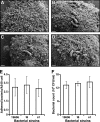Role of acinetobactin-mediated iron acquisition functions in the interaction of Acinetobacter baumannii strain ATCC 19606T with human lung epithelial cells, Galleria mellonella caterpillars, and mice
- PMID: 22232188
- PMCID: PMC3294665
- DOI: 10.1128/IAI.06279-11
Role of acinetobactin-mediated iron acquisition functions in the interaction of Acinetobacter baumannii strain ATCC 19606T with human lung epithelial cells, Galleria mellonella caterpillars, and mice
Abstract
Acinetobacter baumannii, which causes serious infections in immunocompromised patients, expresses high-affinity iron acquisition functions needed for growth under iron-limiting laboratory conditions. In this study, we determined that the initial interaction of the ATCC 19606(T) type strain with A549 human alveolar epithelial cells is independent of the production of BasD and BauA, proteins needed for acinetobactin biosynthesis and transport, respectively. In contrast, these proteins are required for this strain to persist within epithelial cells and cause their apoptotic death. Infection assays using Galleria mellonella larvae showed that impairment of acinetobactin biosynthesis and transport functions significantly reduces the ability of ATCC 19606(T) cells to persist and kill this host, a defect that was corrected by adding inorganic iron to the inocula. The results obtained with these ex vivo and in vivo approaches were validated using a mouse sepsis model, which showed that expression of the acinetobactin-mediated iron acquisition system is critical for ATCC 19606(T) to establish an infection and kill this vertebrate host. These observations demonstrate that the virulence of the ATCC 19606(T) strain depends on the expression of a fully active acinetobactin-mediated system. Interestingly, the three models also showed that impairment of BasD production results in an intermediate virulence phenotype compared to those of the parental strain and the BauA mutant. This observation suggests that acinetobactin intermediates or precursors play a virulence role, although their contribution to iron acquisition is less relevant than that of mature acinetobactin.
Figures






Similar articles
-
The Acinetobacter baumannii entA gene located outside the acinetobactin cluster is critical for siderophore production, iron acquisition and virulence.PLoS One. 2012;7(5):e36493. doi: 10.1371/journal.pone.0036493. Epub 2012 May 3. PLoS One. 2012. PMID: 22570720 Free PMC article.
-
Role of the carboxy terminus of SecA in iron acquisition, protein translocation, and virulence of the bacterial pathogen Acinetobacter baumannii.Infect Immun. 2015 Apr;83(4):1354-65. doi: 10.1128/IAI.02925-14. Epub 2015 Jan 20. Infect Immun. 2015. PMID: 25605767 Free PMC article.
-
Distinctive Roles of Two Acinetobactin Isomers in Challenging Host Nutritional Immunity.mBio. 2021 Oct 26;12(5):e0224821. doi: 10.1128/mBio.02248-21. Epub 2021 Sep 14. mBio. 2021. PMID: 34517755 Free PMC article.
-
Iron acquisition functions expressed by the human pathogen Acinetobacter baumannii.Biometals. 2009 Feb;22(1):23-32. doi: 10.1007/s10534-008-9202-3. Epub 2009 Jan 7. Biometals. 2009. PMID: 19130255 Review.
-
Iron Acquisition Mechanisms and Their Role in the Virulence of Acinetobacter baumannii.Infect Immun. 2022 Oct 20;90(10):e0022322. doi: 10.1128/iai.00223-22. Epub 2022 Sep 6. Infect Immun. 2022. PMID: 36066263 Free PMC article. Review.
Cited by
-
In vitro and in vivo antimicrobial activities of gallium nitrate against multidrug-resistant Acinetobacter baumannii.Antimicrob Agents Chemother. 2012 Nov;56(11):5961-70. doi: 10.1128/AAC.01519-12. Epub 2012 Sep 10. Antimicrob Agents Chemother. 2012. PMID: 22964249 Free PMC article.
-
Analysis of Antimicrobial and Antibiofilm Activity of Human Milk Lactoferrin Compared to Bovine Lactoferrin against Multidrug Resistant and Susceptible Acinetobacter baumannii Clinical Isolates.ACS Infect Dis. 2021 Aug 13;7(8):2116-2126. doi: 10.1021/acsinfecdis.1c00087. Epub 2021 Jun 9. ACS Infect Dis. 2021. PMID: 34105954 Free PMC article.
-
Siderophores in Iron Metabolism: From Mechanism to Therapy Potential.Trends Mol Med. 2016 Dec;22(12):1077-1090. doi: 10.1016/j.molmed.2016.10.005. Epub 2016 Nov 4. Trends Mol Med. 2016. PMID: 27825668 Free PMC article. Review.
-
Exposure to Nanoplastic Particles Enhances Acinetobacter Survival, Biofilm Formation, and Serum Resistance.Nanomaterials (Basel). 2022 Nov 27;12(23):4222. doi: 10.3390/nano12234222. Nanomaterials (Basel). 2022. PMID: 36500844 Free PMC article.
-
Crystal Structure of the Siderophore Binding Protein BauB Bound to an Unusual 2:1 Complex Between Acinetobactin and Ferric Iron.Biochemistry. 2018 Dec 4;57(48):6653-6661. doi: 10.1021/acs.biochem.8b00986. Epub 2018 Nov 15. Biochemistry. 2018. PMID: 30406986 Free PMC article.
References
-
- Abbott A. 2005. Medics braced for fresh superbug. Nature 436:758. - PubMed
-
- Antunes LC, Imperi F, Towner KJ, Visca P. 2011. Genome-assisted identification of putative iron-utilization genes in Acinetobacter baumannii and their distribution among a genotypically diverse collection of clinical isolates. Res. Microbiol. 162:279–284 - PubMed
-
- Brachelente C, Wiener D, Malik Y, Huessy D. 2007. A case of necrotizing fasciitis with septic shock in a cat caused by Acinetobacter baumannii. Vet. Dermatol. 18:432–438 - PubMed
Publication types
MeSH terms
Substances
Grants and funding
LinkOut - more resources
Full Text Sources
Medical
Molecular Biology Databases

